examples(总)
研究生英语视听说答案

Unit 12P162 B.Part 1False complacency: Consumers may feel a false sense of complacency by only shopping differently.Part 2Shopping:One thing we can so to help the environment is turn our shopping cart into a vehicle for social change when we go shopping. Part 3Longer-term issue: Over-consumption by advanced industrial countries is a longer-term issue that we must focus on to save the earth.Part 4Green marketing: We have to be careful of the green marketing that is going on and the hucksters who profit from it.Part 5Revitalizing: We should think about revitalizing our transportation systems rather than which new car to buy.C.1. which of these book titles is not mentioned in the C2.what general purpose do these books have A3. what do Alan During and C4.what one thing does Alice Tepper Marlin A5. what shoud we do when we shop.C6. which comment does Alan Durning not make about C7. who is responsible for over consumption B8.which of the earth’s environmental B9.what specific solution does Durning propose C10.how does Durning see green B11. where do we see a lot of A12.which of the following areas is not mentioned A13. how does Tepper Marlin C14.what negative result could occur C15.what example does Toyota use for C16. what does Durning think we need to focus on A17.what happened in the 1980s, according to AD.1. B which of the following best2. C why does the interviewer3. A what does Durning think aboutUnit 11A Task Listening :which car companies are mentioned as examples of companies that may have to consolidate in the futureRenault, Peugeot and Mazda.B. Part 1 what is becoming more common ,as illustrated by APart 2 what significance does the Daimler Chrysler merger B Part 3 how easy is it to implement cross border APart 4 what impact will the Daimler merger have on CPart 5 what reaction will countries have to the Daimler APart 6 what role will governments play with international BC.Part 1 T Government and business F the scale of T national Part 2 Tthe Daimler merger F According to Jeffrey Garten F The Daimler merger marks the beginningPart 3 T this merger will T cultural differences FOperational Finterntional mergersPart 4 Tin the future Fthe smaller firms Tcompetition will F Renault PeugeotPart 5 T Anti-trust Tthe SEC Fmercedes T CHryslerPart 6 Tthere has been an eclipse Tgovernments have different F governments are able to join acrossD. 1. Fthe significance 2Tthis merger was 3Tthere are more international mergers 4Tsmaller car companies will 5. F In the end , 6T governments are more conservative.Unit 10A Task Listening:what are two examples of nontraditional families mentioned in the report? Gay couples, foster parents, stepfamilies, labor unions, historical societies and unrelated seniors.Part 1 what legal action has been taken in California? California now publicly registers nontraditional groups as families.Part 2 how does Shannom Gibson’s family situation illustrate the situation of many American family today? Shannon Gibson has both a biological father and a stepfather in her family.Part 3 what issue will the states be grappling with for many years? The courts will be grappling with the issue of what constitutes a family.Part 4 how does the family registration certificate help? It could help legitimize John Brown’s status as a single father with dependents.C.1. Awhat is disappearing in the united states?2. Awhich nontraditional groups are mentioned as3. Chow is shanon Gibson like?4. Cwhat concern does Shannon have?5. Chow can a group register?6. Bwhich group is not mentioned as one that?7. Bwhat did the family Diversity?8. Awhat kind of court case caused the state of?9. Bwhich group is not mentioned as s group in California?10. Cwhich two states have registion procedures similar?11. Bhow significant is the family registration? 12. Cwhat role does John play? 13. What does Browm say about his son?B 14. Awhat is likely to happen ti Brown as result?1. Tshannon feel2. Fshannon would rather be3. Tshannon is afraid4. Fthomas coleman thinks5. Fcoleman think it’s easy6. Tcoleman thinks it will take7. TJohn brown feels he has8. Fbrown is confident that the insurance9. T brown is expecting a fightUnit 9 P120A Task listening: Is Olen Kelley against all guns?No, only cheap handguns that are made to kill people.B.Part 1How are some people trying to change gun laws?Some people are trying to stop the sale of Saturday Night Specials.Part 2What happened to Kelley?Olen Kelly was held up and shot.Part 3Who is Kelley suing?He’s suing the manufacturer of Saturday Night Specials.C.1. BStatistics show that many people will2. Bwhat change in the GUN Control Act?3. CSenator Edward try to4. COlen Kelley5. Awhat happened when Kelley tried to open?6. Bwhat did therobbers do to Kelley?7. Cwhere is the maker of the gun located? 8. Bwhat does Kelley say about Knives? 9. C why does Kelley criticize junk guns? 10. C which of the following reasons does Kelley give? 11. Cwhat is Kelley’s most important goal in taking his case to court?D.6. Fkelley would sue the7. FKelley would sue the rifle manufacturer if. 1~5全是对的Unit 8 P106A.where did Lisa Grigg get the ideas for her clinic?From her auto mechanic.B.Part 1Clinic: Lisa Grigg opened a medical clinic in Vermont that accepts no insurance.Part 2Charge:She charges patients for her labor and for parts.Part 3Simple:By not dealing with insurance issues, she can keep her medical care very simple.Part 4Acute care:As an acute care provider, Lisa still encourages herpatients to see their primary care physicians.Part 5Off-the-clock:She will go off-the-clock and talk with her patients when their problems seem to be more serious.C.1. Lisa Grigg “had it”:companies forms2. she hung out a shingle as :acute care3. Patients are charged :fee4. Lisa Grigg charges:two dollars5. in addition to charging for her labor when :suture tray injection6.heritemized bill:minute part7. Lisa Grigg was feeling: fed up with8. the problems she had with: paperwork fighting9.Like her mechanic: price list10. Average co-pays are:ten fifteen11. Lisa Grigg encourages:primary care12. At her last job :eight three five13. Robert Siegel wonders if :billing14. Lisa Grigg is fairly :liberal15.If she thinks a : bruise16. Robert thinks Lisa’s:office managerD.1.Cwhat attitude does Lisa Grigg express in her answer?2. Awhatattitude does Robert Siegel expressin his comment? 3. Bwhat attitude does Lisa Grigg express ? 4. Cwhat attitude does Robert express in his question?Unit 7 P90A.how old was George Soros when he first started trading in currency? He was 14 years old.B.Part 1Multibillionaire :Multibillionaire and philanthropist George Soros became one of the world’s wealthiest men through his work as a financier.Part 2anxious:Managing people’s money and taking risks made him anxious.Part 3experiences in trading :His experiences in trading began when he was 14. as a Hungarian Jew hiding from the Nazis.Part 4feelings about money:Soros has uncomfortable feelings about his reputation to make money and would rather be known as a thinker. Part 5goal :His goal is to make a contribution to make the world a better place.C.1. Bwhat is special about Tuesdays on Morning Edition?2. Bhow is George soros described?3. Awhich of the following is not true4. Bwhat’s the problem with managing ?5. Bwhat negative effect might Scros’scyrrency trading6. Cwhich of the following is not true about Soros’s7. B which of the following is true about the 14 old years?8. Cwhat lesson did George learn?9. Bhow did young George feel about his experiences 10. Awhich of the following describes George background? 11. Cwhich of describes George’s plan? 12. B how would Soros have liked to be appreciated? 13. B what fascinates Soros? 14. Cwhat does heving money allow Soros to do?15. C how does soros react to the idea that he is ? 16. Bwhich of the following is not correct in 17. Ahow does Sorod feel about giving money?18. Chow would George Soros like to be remembered? Unit 6B.1.What has Benetton done that has caused controversy?Benettonhas produced a set of controversial ads.2.How do the Benetton ads help the company?The ads createcontroversy and generate publicity for the company.3.How do the views of the newborn-baby ad differ?Some say the adof the newborn is disgusting, while others say it is magnificent and natural.4.According to Bob Garfield, what two purposes do these adshave?The ads benefit publicity while they distract consumers from Benetton’s high prices.C.1.Awhich of the following is not true?2. C which of the followingdoes not describe one of the Benetton ads? 3. Awhy is Garfield being interviewed? 4. Bwhy does Garfield think Benetton has produced? 5. Chow does Garfield think people probably react when they see the ad? 6. Cwhich description does Garfield think Benetton would use to ? 7. Ain discussing the newborn baby,what does imagine? 8. Bwhich magazine published the ad with the newborn baby? 9. A how does the interviewer teaact to the magazines? 10. Cwhat did Benetton espect to happen with these ads? 11. Bwhy does Garfield think Benetton’sadvertising is cunning? 12. C what does Garfield say about Benetton’s prices?。
2020年中考英语考点突破:书面表达一(学生版)
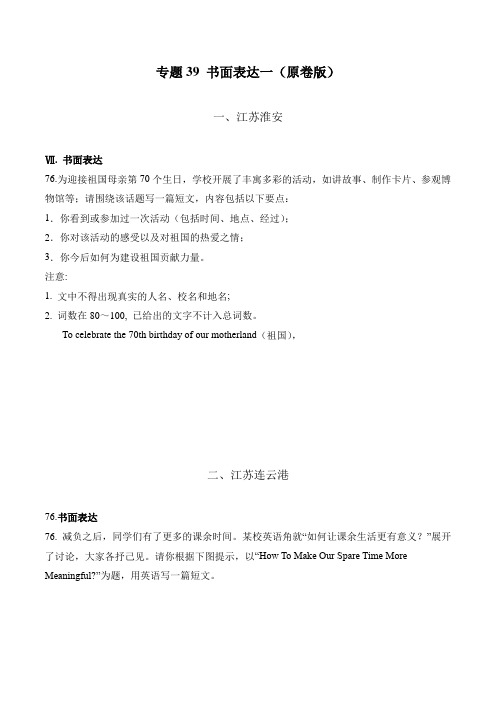
专题39 书面表达一(原卷版)一、江苏淮安Ⅶ. 书面表达76.为迎接祖国母亲第70个生日,学校开展了丰寓多彩的活动,如讲故事、制作卡片、参观博物馆等;请围绕该话题写一篇短文,内容包括以下要点:1.你看到或参加过一次活动(包括时间、地点、经过);2.你对该活动的感受以及对祖国的热爱之情;3.你今后如何为建设祖国贡献力量。
注意:1. 文中不得出现真实的人名、校名和地名;2. 词数在80~100, 已给出的文字不计入总词数。
To celebrate the 70th birthday of our motherland(祖国),______________________________________________________________________________________________________________________ _________________________________________________________________________________ _________________________________________________________________________________ _________________________________二、江苏连云港76.书面表达76. 减负之后,同学们有了更多的课余时间。
某校英语角就“如何让课余生活更有意义?”展开了讨论,大家各抒己见。
请你根据下图提示,以“How To Make Our Spare Time More Meaningful?”为题,用英语写一篇短文。
注意:(1)短文应包括所给内容要点,可适当发挥,使文章连贯;(2)词数90左右,短文开头已给出,不计入总词数;(3)短文中不得出现考生的真实姓名、校名等信息。
(4)参考词汇:提升素养promote literacyHow To Make Our Spare Time More Meaningful?Nowadays, we students have much more spare time than ever before, but how to make our spare time more meaningful?_________________________________________________________________________________ _________________________________________________________________________________ _________________________________________________________________________________ _________________________________________________________________________________ _________________________________________________________________________________ _________________________________________________________________________________ _________________________________________________________________________________ _________________________________________________________________________________ _______________________________________________________________三、江苏苏州第七部分书面表达56.假定你是苏华,最近你的澳大利亚笔友Nathan犯了一些错误,倍感懊恼,写了一封邮件向你诉说,为帮助他排解困感,请你根据他的邮件内容并结合自身经历.用英语回信开导他。
半导体物理总复习例题
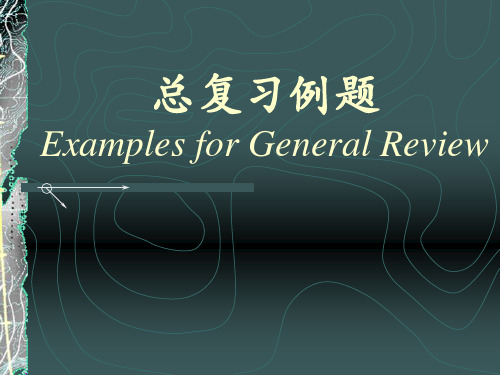
nb= m
EF 金属
qUJ = m - s
s - s
EF EC
N 型半导体 EV
平衡时整个系统的费米 能级统一一致。电子的 势垒高度为 nb = m , Schottky 结上电压
UJ = (m - s ) /q
此时从金属向半导体发 射的热电子流等于从半 导体向金属注入的电子 流,故 Schottky 结无净电 流流过。
If IsexpqkU Tf 1
考虑到二极管施加正向 电 压 ( 譬 如 ≥ 0.6V ) 时 , 方 括号中的指数项明显大 于1,故上式可近似改写 为
If
Is
e
xp
q Uf kT
两边求对数,得
Uf
k Tn I f q Is
上式两边同时对 T 求导, 整理后有
d dU fTIf常= 数 U Tf- q ksT Id dsI.T................1 ......
Lp Ln
n p
Lp Ln
n p
例12, 利用耗尽层近似, 求 n 型半导体表面耗尽层 宽度 xd 和空间电荷面密 度量 QS 随表面势 US 变化 的公式。
解:
设 n 型半导体中施主杂 质均匀分布,即施主密度 Nd 是常数。 采用耗尽层近似,故施主 杂质全部电离,电子基本 耗尽,表面如图所示,
SiO2 EFm
EC EFS Ei
EV
平带 UG = 0
积累层情况,如下图:
SiO2
EC
EFS
EFm
Ei
EV
表面积累 UG > 0
耗尽层情况,如下图:
SiO2
ห้องสมุดไป่ตู้
EFm
EC
2017年高考英语“七选五”阅读总动员:“七选五”阅读3.题型讲解

3.●Self Expression _____ There are many ways to express thoughts and ideas—music, acting, drawing, building, photography. You may find that your child is attracted by one more than another. B. And we can’t forget science education. C. We can give kids chances to think about materials in new ways. G. Being able to communicate ideas in a meaningful way is a valuable skill.
D. Tell your child why he can —or cannot—have certain things. E. Ask yourself what things that cost money are most important to you. F. Talk about how the money bought the thing after you leave the toy store.
C 要求选段中衔接句。空格前后句中的new, materials与选项C中的new, materials是 原词复现,代入检验,的确上下连贯,故选C项。
2. You didn’t lose “everything”. Once trust is lost, what is left? Instead of looking at the situation from this hopeless angle, look at everything you still have and be thankful for all of the good in your life. _____ Instead, it’s a healthy way to work through the experience to allow room for positive growth and forgiveness.
译林版)小学英语动词过去式归类总结

译林版)小学英语动词过去式归类总结XXXI。
Regular XXX XXX1.In general。
add -ed to the end of the verb.Examples: work --- worked。
play --- played。
want --- wanted。
act --- acted2.For verbs ending in silent -e。
add -d and remove the final -e。
then add -e/-ed.Examples: live --- lived。
move --- moved。
like --- liked。
hope --- hopedII。
XXX XXX1.Change the -o in the base form to -a to form the past tense.Examples: e --- became。
come --- came2.Change the -i in the base form to -a to form the past tense.Examples: begin --- XXX。
drink --- drank。
give --- gave。
ring --- rang。
sing --- sang。
sit --- sat。
swim --- swam3.Change the -i in the XXX to -o to form the past tense.Examples: drive --- drove。
ride --- rode。
win --- won。
write --- wrote4.Change the -e in the base form to -o to form the past tense.Examples: get --- got。
et --- ot5.Change the -eep in the base form to -ept to form the past tense.Examples: keep --- kept。
英文小组讨论句型总结范文
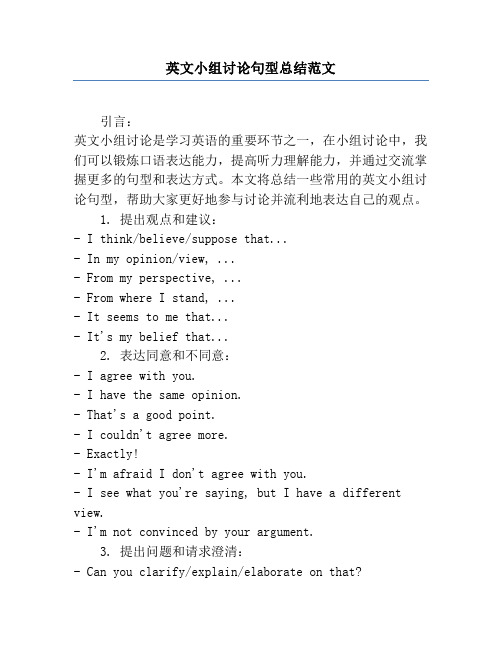
英文小组讨论句型总结范文引言:英文小组讨论是学习英语的重要环节之一,在小组讨论中,我们可以锻炼口语表达能力,提高听力理解能力,并通过交流掌握更多的句型和表达方式。
本文将总结一些常用的英文小组讨论句型,帮助大家更好地参与讨论并流利地表达自己的观点。
1. 提出观点和建议:- I think/believe/suppose that...- In my opinion/view, ...- From my perspective, ...- From where I stand, ...- It seems to me that...- It's my belief that...2. 表达同意和不同意:- I agree with you.- I have the same opinion.- That's a good point.- I couldn't agree more.- Exactly!- I'm afraid I don't agree with you.- I see what you're saying, but I have a different view.- I'm not convinced by your argument.3. 提出问题和请求澄清:- Can you clarify/explain/elaborate on that?- Could you give me more details/examples?- I'm not sure I understand. Could you please rephrase that?- Sorry, I didn't catch the last part. Could you repeat it?4. 引用他人观点和证据:- According to [expert/researcher], ...- [Expert/researcher] claims/suggests that...- [Statistic/fact] shows/proves that...- [Source] states that...5. 表示赞同和反对:- I absolutely agree with/endorse/support that idea. - I strongly agree/disagree with that statement.- I partially agree with you, but...- I can see some merits in your argument, but I have some reservations.6. 提出解决问题的建议:- One possible solution/approach could be...- We could consider/try...- It might be worth trying...- How about...- Have you thought about...7. 表示问询和回答:- May I ask a question?- Can you tell me...- Do you know...- I'm not sure, but I think...- I don't have enough information to answer that.8. 表示总结和结论:- In conclusion,...- To sum up,...- All in all,...- Taking everything into consideration,...- Based on the information we have, it seems that...结论:英文小组讨论是提高英语口语和听力能力的有效方法,通过总结以上常用句型,我们可以更流利地表达自己的观点,与他人进行更高效的交流。
2021新课标名师导学高考英语译林版第一轮总复习考点集训(三十三) 一、名词

考点集训(三十三)一、名词对应学生用书p339Ⅰ.在空白处填入括号内单词的正确形式。
1.The two ____________(factory) were moved outside the city last year.2.Without passion, people won’t have the ____________(motivate) or the joy necessary for creative thinking.3.Then, handle the most important tasks first so you’ll feel a real sense of ____________(achieve).4.At some point we need to make sure that our ____________(expect) are the same as our ____________(friend) expectations.5.Whenever I made mistakes,the teacher pointed them out with ____________(patient).6.We are trying to reduce ____________(poor) and increase people’s income.7.To our great ____________(relieve), the accident caused little damage.8.They are busy making ____________(prepare) for the wedding.9.We should look up to him as a shining example of ____________(devote) to duty.10.People’s ____________(choose) of colors is also influenced by their bodies’ reactions towards them.11.Keep it in mind that everyone has ____________(strong) and weaknesses.12.No official ____________(permit) has been given for the event to take place.13.We have reduced air pollution through many ____________(strategy).14.Some people think that the great Chinese scholar Confucius,who lived from roughly 551 to 479 B.C.,influenced the ____________(develop) of chopsticks.15.—Why was it that you lost all your ____________(key)?—It was because of my carelessness.16.When you see the sunlight, ____________(passer-by) or trees outside might make you more aware of how you look, or might make you think about walking.17.You should take more ____________(exercise). Don't always sit at the desk busy doing your ____________(exercise).18.The sisters were treated as local ____________(hero) after rescuing a two-year-old boy from the river.19.Her ____________ (tooth) are false, but they look very natural.20.The ____________ (deer) in the forest are all dying off from disease.[答案与解析]1.factories。
领导力(测试题)

领导力(测试题)1.你是否经常拒绝别人的请求?是或否?2.即使你知道自己是正确的,你是否还是会避免与人争执?是或否?3.你是否遵守一般法规?是或否?4.你是否经常道歉?是或否?5.如果有人嘲笑你的衣服,你会再穿一次吗?是或否?6.你是否总是走时尚的前沿?是或否?7.你是否曾经穿过漂亮但不舒适的衣服?是或否?8.在开车或乘车时,你是否曾经咒骂其他驾驶者?是或否?9.你是否对反应较慢的人没有耐心?是或否?10.你是否经常对人发誓?是或否?11.你是否经常让别人感到自卑或比你差?是或否?12.你是否曾经强烈批评过电视上的言论?是或否?13.如果你请的工人没有做好,你会采取行动吗?是或否?14.你是否惯于坦白自己的想法,而不考虑后果?是或否?15.你是否是一个不轻易容忍别人的人?是或否?16.在与人争论时,你是否总是想赢?是或否?17.你是否总是让别人替你做重要的事?是或否?18.你是否喜欢将钱投资在财富上,而不是个人成长?是或否?19.你是否故意在穿着上吸引他人的注意?是或否?20.你是否不喜欢标新立异?是或否?测试说明:回答“是”得1分,回答“否”得0分。
得分14-20分:你是一个标准的跟随者,不适合领导别人。
你喜欢被动地听从指挥。
在紧急情况下,你可能不会主动带领群众,但你很愿意与大家配合。
得分7-13分:你是一个处于领导者和跟随者之间的人。
你可以随时带领或指挥别人该怎么做。
但由于你的个性不够积极,冲劲不足,所以经常扮演跟随者的角色。
得分6分以下:你是一个天生的领导者。
你的个性很强,不愿接受别人的指挥。
你喜欢指挥别人,如果别人不愿意听从,你就会变得很叛逆,不肯轻易服从别人。
领导者成功测试问卷:1.你是否已经确定了具体的职业目标?是或否?2.你是否制定了实现目标的职业计划?是或否?3.你是否有更高的愿望?是或否?4.你的愿望是否实际可行?是否与你的能力相符?是或否?5.你是否随时准备去冒险、犯错、失败?是或否?6.你是否会重新安排工作?是或否?7.你是否忠实地为你的公司负责?是或否?8.你是否坚信自己能够幸运?是或否?9.为了在工作中取得最好的成绩,你是否会努力工作?是或否?测试说明:回答“是”得1分,回答“否”得0分。
语言学——精选推荐
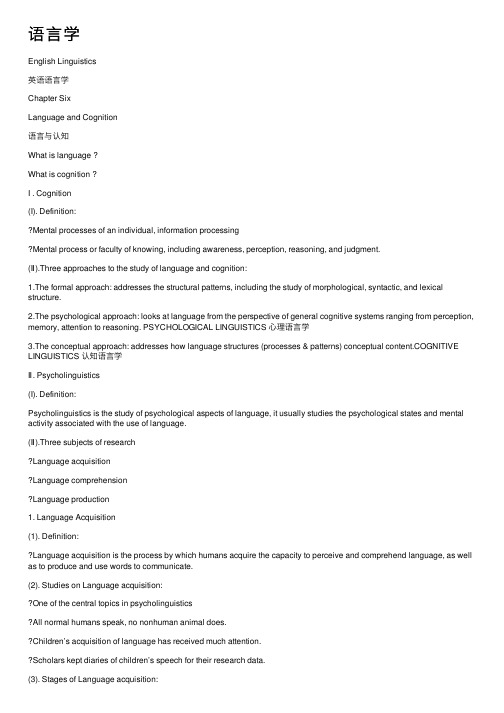
语⾔学English Linguistics英语语⾔学Chapter SixLanguage and Cognition语⾔与认知What is language ?What is cognition ?I . Cognition(I). Definition:Mental processes of an individual, information processingMental process or faculty of knowing, including awareness, perception, reasoning, and judgment.(Ⅱ).Three approaches to the study of language and cognition:1.The formal approach: addresses the structural patterns, including the study of morphological, syntactic, and lexical structure.2.The psychological approach: looks at language from the perspective of general cognitive systems ranging from perception, memory, attention to reasoning. PSYCHOLOGICAL LINGUISTICS ⼼理语⾔学3.The conceptual approach: addresses how language structures (processes & patterns) conceptual content.COGNITIVE LINGUISTICS 认知语⾔学Ⅱ. Psycholinguistics(I). Definition:Psycholinguistics is the study of psychological aspects of language, it usually studies the psychological states and mental activity associated with the use of language.(Ⅱ).Three subjects of researchLanguage acquisitionLanguage comprehensionLanguage production1. Language Acquisition(1). Definition:Language acquisition is the process by which humans acquire the capacity to perceive and comprehend language, as well as to produce and use words to communicate.(2). Studies on Language acquisition:One of the central topics in psycholinguisticsAll normal humans speak, no nonhuman animal does.Children’s acquisition of language has received much attention.Scholars kept diaries of children’s speech for their research data.(3). Stages of Language acquisition:a. Holophrastic stage (from two months to a year)–Language’s sound patterns–Phonetic distinctions in parents’ language.–One-word stage: objects, actions, motions, routines.b.Two-word stage (around 18 months)c. Three-word stage–Give doggie paper.–Put truck window.–Tractor go floor.d. Fluent grammatical conversation stageEmbed one constituent inside another:–Give doggie paper.–Give big doggie paper.Use more function words: missing function words and inflection in the beginning but good use (90%) by the age of 3, with a full range of sentence types.All parts of a language are acquired before the child turns four.2. Language comprehension(1). Definition:The mental process in which humans can understand sentences that carry novel messages in a way exquisitely sensitive to the structure of the language.(2). Stages of language comprehension:a. word recognitionb. comprehension of sentencesc. comprehension of texts3. Language production(1). Definition:In psycholinguistics, language production is the production of spoken or written language. It describes all of the stages between having a concept, and translating that concept into linguistic form.(2). Stages of language production:a. access to wordsb. generation of sentencesc. written language productionⅢ. Cognitive LinguisticsDefinition:It is the scientific study of the relation between the way we communicate and the way we think. ?It is based on human experiences of the world and the way they perceive and conceptualize the (I) Construal and Construal Operations (识解与识解活动)Construal: the ability to conceive and portray the same situation in different waysConstrual Operations include the following aspects:Attention / salience(注意⁄突显)We activate the most relevant concepts more than concepts that are irrelevant to what we are thinking about.a We drove along the road.(a line:one-dimenaional)b. She ran across the road.(a surface:two-dimenaional)c. The workers dug through the road.(a volume:three-dimenaional)a. He cleaned the window. (glass)b. He opened the window. (frame)a. I’ve broken the window. (I)b. A stone has broken the window. (stone)2. Judgment / Comparison (判断⁄⽐较)Figure / Ground (图形⁄背景)We cannot attend to all facets of a scene at the same time.We cannot pay attention to everything. Instead, we focus on events of particular salience. ?Figure-ground organization –The ground seems to be placed behind the figure extending in the background.–The figure is thus more prominent, or even more interesting, than the ground.Figure-groundFigure-ground also seems to apply to our perception of moving objects.In order to distinguish between stationary and dynamic figure-ground relations, some cognitive linguists (eg Ronald Langacker) use the term trajector (射体)for a moving figure and landmark (界标)for the ground of a moving figure. There’s a cat[figure] on the mat[ground]There are still some peanuts[figure] in the bag[ground]Batman[figure] was standing on the roof[ground]The computer[figure] under the table[ground] is mineThe spacecraft[figure] was hovering over Metropolis[ground]Tarzan[trajector] jumped into the river[landmark]Spiderman[trajector] climbed up the wall[landmark]The bird[trajector] winged its way out the window[landmark]We[trajector] went across the field[landmark]I[trajector]’m going to London[landmark]3. Perspective⁄Situatedness(视⾓⁄情景)Perspective :the way in which we view a scene in terms of our situatedness. It generally depends on two things: where we are situated in relation to the scene we're viewinghow the scene is arranged in relation to our situatedness.–The tree is behind the man.–The tree is in front of the man.(Ⅱ) Categorization(范畴化)1. Definition:The process of classifying our experiences into different categories based on commonalities and differences.2. Three levels in categories:–basic level–superordinate level–subordinate levelBasic level Superordinate levelAnimalHorse Dog CatChihuahua German dachshundshepherdSubordinate levelVertical organization(Ⅲ) Image Schema(意象图式)Definition:A recurring, dynamic pattern of our perceptual interactions and motor programs that gives coherence and structure to our experience (Mark Johnson).2. Patterns of image schemas:Center-periphery schema(中央—边缘图式)Involves–a physical or metaphorical core and edge, and–degrees of distance from the core.Examples (English):–The structure of an apple–An individual’s perceptual sphere–An individual’s social sphere, with family and friends at the core and others having degrees of peripherality (周边性)Containment schema(容器图式)Involves a physical or metaphorical–boundary–enclosed area or volume, or–excluded area or volume.Bodily experience: human bodies as containers.Structural elements: interior, boundary, exterior–The ship is coming into view.–She’s deep in thought.–We stood in silence.Cycle schema (循环图式)Involves repetitious events and event series. Its structure includes the following:–A starting point–A progression through successive events without backtracking–A return to the initial stateThe schema often has superimposed on it a structure that builds toward a climax and then goes through a release or decline.Examples (English)–Days–Weeks–Years–Sleeping and waking–Breathing–Circulation–Emotional buildup and releaseForce schema (⼒量图式)Involves physical or metaphorical causal interaction. It includes the following elements:–A source and target of the force–A direction and intensity of the force–A path of motion of the source and/or target–A sequence of causationExamples (English):–Physical: Wind, Gravity–Structural elements: force, path, entity, etc.–Interaction, directionality, causality–Compulsion–Blockage–Counterforce–Diversion–Removal of restraintLink schema(连接图式)Consists of two or more entities, connected physically or metaphorically, and the bond between them.Entity A Entity BExamples (English):–A child holding her mother’s hand–Someone plugging a lamp into the wall–A causal “connection”–Kinship “ties”Part-whole schema(部分—整体图式)Involves physical or metaphorical wholes along with their parts and a configuration of the parts.Examples (English):–Physical: The body and its parts–Metaphorical: The familyPath schema(路径图式)Involves physical or metaphorical movement from place to place, andconsists of a starting point, a goal, and a series of intermediate points.Examples (English):Physical: Paths; TrajectoriesMetaphorical: The purpose-as-physical-goal metaphor, as expressed in the following sentences: –Tom has gone a long way toward changing his personality.–You have reached the midpoint of your flight training.–She's just starting out to make her fortune.–Jane was sidetracked in her search for self-understanding.Scale schema(刻度图式)Involves an increase or decrease of physical or metaphorical amount, andconsists of any of the following:–A closed- or open-endedprogression of amount–A position in the progressionof amount–One or more norms of amountExamples:–Physical amounts–Properties in the number system–Economic entities such as supply and demandVerticality schema(垂直图式)Involves “up” and “down” relations.Examples:–Standing upright–Climbing stairs–Viewing a flagpole–Watching water rise in a tub(Ⅳ) MetaphorGeorge Lakoff and Mark Johnson (1980). Metaphors We Live By. University of Chicago Press. <中⼩学英语教学与研究>2011第6期英语中的概念隐喻表达法崔传明⽯磊(⼭东科技⼤学,⼭东泰安271000)隐喻(metaphor)就是把⼀个领域的概念投射到另⼀领域,或者说从⼀个认知域—来源(source domain)投射到另⼀个认知域—⽬标域(target domain)。
【2023年】河南省安阳市-统招专升本英语预测试题(含答案)
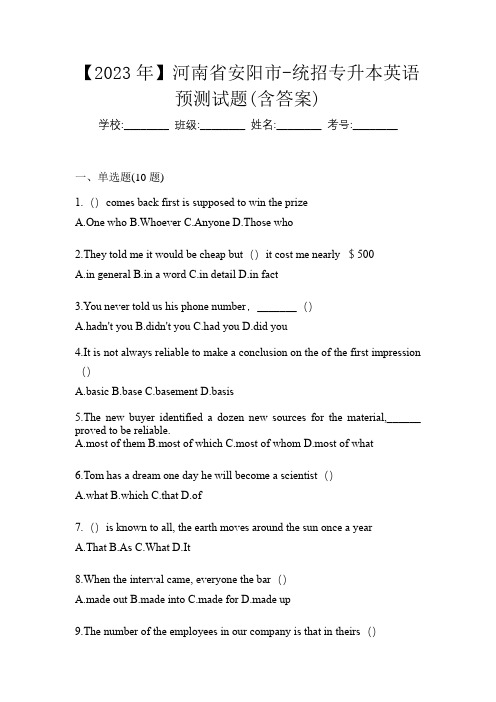
【2023年】河南省安阳市-统招专升本英语预测试题(含答案)学校:________ 班级:________ 姓名:________ 考号:________一、单选题(10题)1.()comes back first is supposed to win the prizeA.One whoB.WhoeverC.AnyoneD.Those who2.They told me it would be cheap but()it cost me nearly $500A.in generalB.in a wordC.in detailD.in fact3.You never told us his phone number,_______()A.hadn't youB.didn't youC.had youD.did you4.It is not always reliable to make a conclusion on the of the first impression ()A.basicB.baseC.basementD.basis5.The new buyer identified a dozen new sources for the material,______ proved to be reliable.A.most of themB.most of whichC.most of whomD.most of what6.Tom has a dream one day he will become a scientist()A.whatB.whichC.thatD.of7.()is known to all, the earth moves around the sun once a yearA.ThatB.AsC.WhatD.It8.When the interval came, everyone the bar()A.made outB.made intoC.made forD.made up9.The number of the employees in our company is that in theirs()A.twice as large asB.twice as many thanC.as twice many asD.as twice as10.Your explanation is still not easy enough to understand. Could you give anyexamples()A.specificB.specialC.specialistD.spare二、完型填空(10题)11.52.()A.betweenB.onC.inD.for12.33.()A.no one elseB.anyone elseC.someone elseD.everyone else13.()A.springB.raiseC.swellD.rise14.55.()A.gettingB.to getC.getD.having gotten15.Much has been made about the importance of a good breakfast to a healthy lifestyle. It gives you___31___ to start your day, according to conventional wisdom((传统观念), and scientific studies ___32___adecade ago had shownthat eating breakfast was the key to maintaining a healthy weight. Breakfast skippers are plagued (饱受困扰)with well-meaning family members and friends, ___33___that they should eat something in the morning. But according to nutrition scientist P.K. Newby, such advice was based on what’s known as observational studies, in which scientists follow groups of people and ___34___ the outcomes. The result had seemed to indicate that people ___35___ lost weight or maintained a healthy weight ate breakfast. The problem, Newby told us, is that those studies didn’t isolate breakfast as the important factor.It could be, she says, that those who lost weight alsoexercise more.Then, in 2014, a group of researchers at the University of Alabama published a study that took a more___36___ look at this question. They had 300 participants and ___37___ assigned them to eat breakfast, to skip breakfast, or to simply go about their normal routine. After 16 weeks, they found no difference in weight loss___38___ the three groups.___39___ on this new research, it seems that the bottom line is this: if you’re not hungry in the morning,there’s no ___40___ in skipping breakfast when it comes to weight management. It’s the what that is more important than the when, when it comes to breakfast, she says31.()A.powerB.energyC.courageD.confidence16.79.()A.WhoB.WhatC.ItD.Which17.72.()A.withB.amongC.toD.in18.23.()A.rapidlyB.harmlesslyC.endlesslyD.separately19.63.()A.otherB.anotherC.the otherD.one20.31.()A.the momentB.the first timeC.whileD.before三、翻译(3题)21.正是那棵树在洪水中救了他们的命22.暴风雨增加了士兵们营救被火灾困住的人们的困难23.As long as we take a down-to-earth attitude in doing whatever we do, we are sure to gain something from what we have done四、词汇与语法(3题)24.His proposal that the direction of the company's development()sounds reasonable25.Here is a paper ________ for you to dry your hands()26.Top graduates from universities are often ________ by major international companies()五、单选题(0题)27.If you carefully _____ the problem again, you will find a way out()A.think overB.take overC.set upD.look up六、单选题(0题)28.Why not ______ to Professor Smith for advice? He is an expert in this field ()A.goB.your goingC.to goD.you go参考答案1.BB句意:无论是谁第一个回来都应该赢得奖品。
15544+自动化专业英语(习题参考解答)
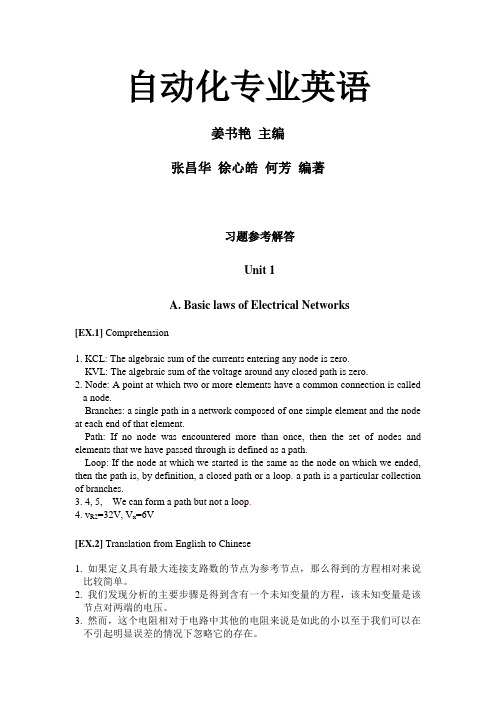
自动化专业英语姜书艳主编张昌华徐心皓何芳编著习题参考解答Unit 1A. Basic laws of Electrical Networks[EX.1] Comprehension1. KCL:The algebraic sum of the currents entering any node is zero.KVL:The algebraic sum of the voltage around any closed path is zero.2. Node: A point at which two or more elements have a common connection is calleda node.Branches: a single path in a network composed of one simple element and the node at each end of that element.Path: If no node was encountered more than once, then the set of nodes and elements that we have passed through is defined as a path.Loop: If the node at which we started is the same as the node on which we ended, then the path is, by definition, a closed path or a loop. a path is a particular collection of branches.3. 4, 5, We can form a path but not a loop.4. v R2=32V, V x=6V[EX.2] Translation from English to Chinese1. 如果定义具有最大连接支路数的节点为参考节点,那么得到的方程相对来说比较简单。
作文 总会找到的 点题例子
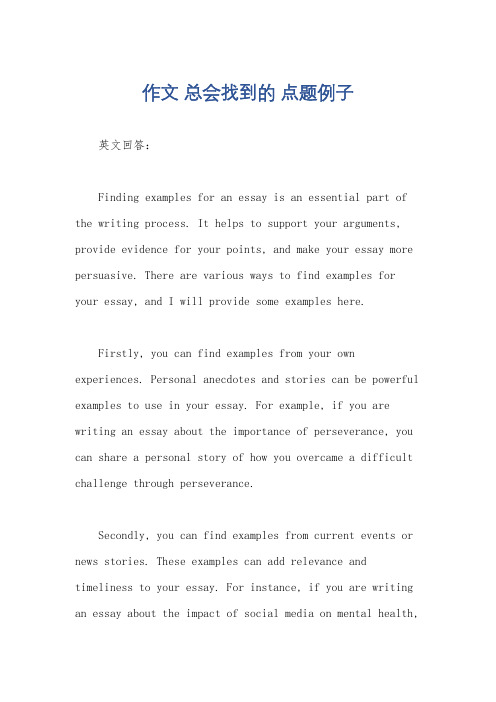
作文总会找到的点题例子英文回答:Finding examples for an essay is an essential part of the writing process. It helps to support your arguments, provide evidence for your points, and make your essay more persuasive. There are various ways to find examples for your essay, and I will provide some examples here.Firstly, you can find examples from your own experiences. Personal anecdotes and stories can be powerful examples to use in your essay. For example, if you are writing an essay about the importance of perseverance, you can share a personal story of how you overcame a difficult challenge through perseverance.Secondly, you can find examples from current events or news stories. These examples can add relevance and timeliness to your essay. For instance, if you are writing an essay about the impact of social media on mental health,you can include recent news stories or studies to support your points.Thirdly, you can find examples from history or literature. Drawing examples from historical events or classic literature can add depth and richness to your essay. For example, if you are writing an essay about the consequences of unchecked power, you can refer tohistorical figures or literary characters to illustrateyour points.In addition, you can also find examples from academic research or scholarly articles. Citing studies and research findings can add credibility and authority to your essay. For instance, if you are writing an essay about thebenefits of exercise, you can include statistics andfindings from scientific studies to back up your claims.Overall, there are many sources from which you can find examples for your essay. Whether it's from personal experiences, current events, history, literature, or academic research, using relevant and compelling examplescan greatly enhance the quality of your essay.中文回答:在写作中找到例子是写作过程中的一个重要部分。
用来总结的英文作文
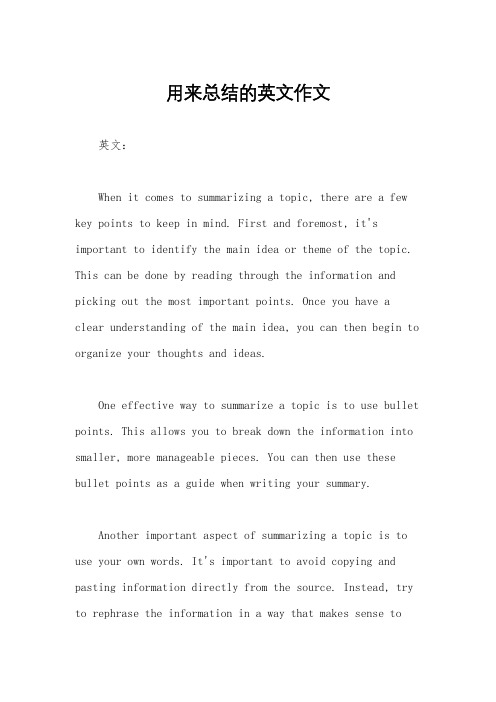
用来总结的英文作文英文:When it comes to summarizing a topic, there are a few key points to keep in mind. First and foremost, it's important to identify the main idea or theme of the topic. This can be done by reading through the information and picking out the most important points. Once you have a clear understanding of the main idea, you can then begin to organize your thoughts and ideas.One effective way to summarize a topic is to use bullet points. This allows you to break down the information into smaller, more manageable pieces. You can then use these bullet points as a guide when writing your summary.Another important aspect of summarizing a topic is to use your own words. It's important to avoid copying and pasting information directly from the source. Instead, try to rephrase the information in a way that makes sense toyou.When summarizing a topic, it's also important to include examples. This helps to illustrate the main ideas and make them more relatable. For example, if you were summarizing a topic on the benefits of exercise, you could include examples of different types of exercises and how they can improve overall health.Overall, summarizing a topic requires careful reading, organization, and the ability to use your own words. By following these tips and including examples, you can create a concise and effective summary.中文:总结一个话题时,有几个关键点需要记住。
general 词源
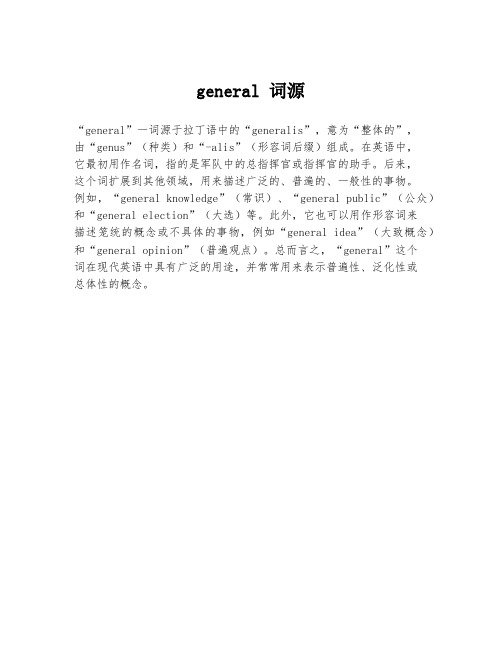
general 词源
“general”一词源于拉丁语中的“generalis”,意为“整体的”,
由“genus”(种类)和“-alis”(形容词后缀)组成。
在英语中,
它最初用作名词,指的是军队中的总指挥官或指挥官的助手。
后来,
这个词扩展到其他领域,用来描述广泛的、普遍的、一般性的事物。
例如,“general knowledge”(常识)、“general public”(公众)和“general election”(大选)等。
此外,它也可以用作形容词来
描述笼统的概念或不具体的事物,例如“general idea”(大致概念)和“general opinion”(普遍观点)。
总而言之,“general”这个
词在现代英语中具有广泛的用途,并常常用来表示普遍性、泛化性或
总体性的概念。
个人的能力特点总结
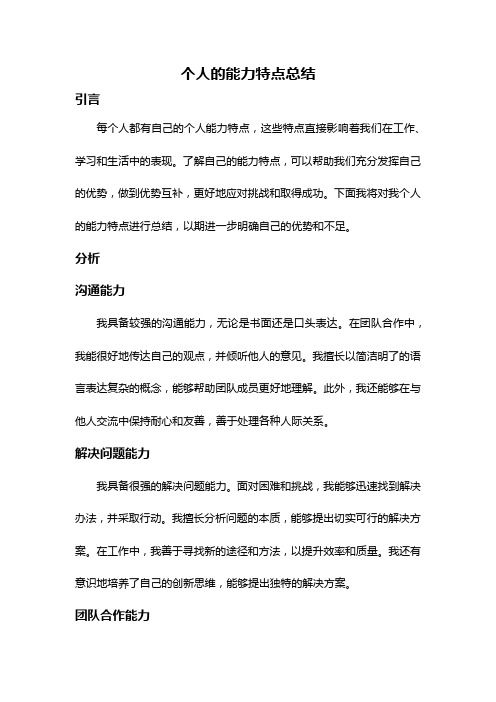
个人的能力特点总结引言每个人都有自己的个人能力特点,这些特点直接影响着我们在工作、学习和生活中的表现。
了解自己的能力特点,可以帮助我们充分发挥自己的优势,做到优势互补,更好地应对挑战和取得成功。
下面我将对我个人的能力特点进行总结,以期进一步明确自己的优势和不足。
分析沟通能力我具备较强的沟通能力,无论是书面还是口头表达。
在团队合作中,我能很好地传达自己的观点,并倾听他人的意见。
我擅长以简洁明了的语言表达复杂的概念,能够帮助团队成员更好地理解。
此外,我还能够在与他人交流中保持耐心和友善,善于处理各种人际关系。
解决问题能力我具备很强的解决问题能力。
面对困难和挑战,我能够迅速找到解决办法,并采取行动。
我擅长分析问题的本质,能够提出切实可行的解决方案。
在工作中,我善于寻找新的途径和方法,以提升效率和质量。
我还有意识地培养了自己的创新思维,能够提出独特的解决方案。
团队合作能力我具备良好的团队合作能力。
在团队中,我能够与他人合作,协调各方的利益,达成共识。
我擅长在团队合作中担任领导者的角色,能够合理安排任务和资源,推动团队目标的实现。
我善于发现和发挥团队成员的才能,使每个人都能充分发挥自己的优势,共同完成任务。
学习能力我具备良好的学习能力。
无论是在学校还是在职场,我都能迅速学习和掌握新的知识和技能。
我擅长主动寻找学习机会,善于利用各种资源和渠道进行自我提升。
我注重理论与实践的结合,能够将学到的知识应用到实际问题中。
此外,我还有很强的自我驱动力,能够持续学习和进步。
时间管理能力我具备较好的时间管理能力。
我擅长制定合理的计划和目标,能够高效地安排自己的工作和学习。
我注重优先级的确定,能够根据重要性和紧急程度来合理安排时间。
我遵循“做事在前,做人在后”的原则,能够合理处理时间和任务之间的关系,保证工作和学习的平衡。
总结通过对个人能力特点的分析和总结,我更加明确了自己的优势和不足,以及在工作、学习和生活中的应用。
我将继续发扬自己的优势,通过不断学习和提升,进一步完善自己的能力。
total的用法总结大全
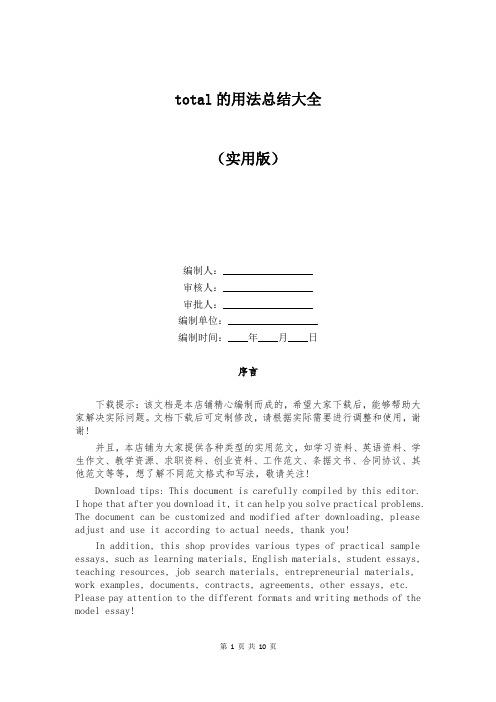
total的用法总结大全(实用版)编制人:__________________审核人:__________________审批人:__________________编制单位:__________________编制时间:____年____月____日序言下载提示:该文档是本店铺精心编制而成的,希望大家下载后,能够帮助大家解决实际问题。
文档下载后可定制修改,请根据实际需要进行调整和使用,谢谢!并且,本店铺为大家提供各种类型的实用范文,如学习资料、英语资料、学生作文、教学资源、求职资料、创业资料、工作范文、条据文书、合同协议、其他范文等等,想了解不同范文格式和写法,敬请关注!Download tips: This document is carefully compiled by this editor.I hope that after you download it, it can help you solve practical problems. The document can be customized and modified after downloading, please adjust and use it according to actual needs, thank you!In addition, this shop provides various types of practical sample essays, such as learning materials, English materials, student essays, teaching resources, job search materials, entrepreneurial materials, work examples, documents, contracts, agreements, other essays, etc. Please pay attention to the different formats and writing methods of the model essay!total的用法总结大全total的用法你知道吗?今天本店铺给大家带来total的用法,希望能够帮助到大家,下面本店铺就和大家分享,来欣赏一下吧。
连接词总..
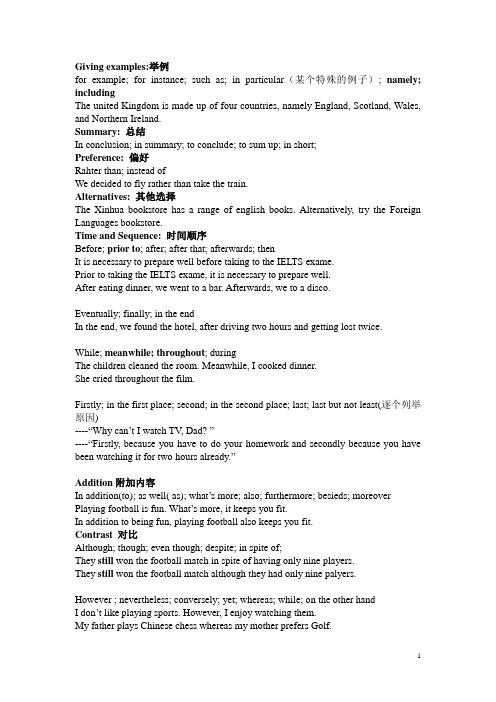
Giving examples:举例for example; for instance; such as; in particular(某个特殊的例子); namely; includingThe united Kingdom is made up of four countries, namely England, Scotland, Wales, and Northern Ireland.Summary: 总结In conclusion; in summary; to conclude; to sum up; in short;Preference: 偏好Rahter than; instead ofWe decided to fly rather than take the train.Alternatives: 其他选择The Xinhua bookstore has a range of english books. Alternatively, try the Foreign Languages bookstore.Time and Sequence: 时间顺序Before; prior to; after; after that; afterwards; thenIt is necessary to prepare well before taking to the IELTS exame.Prior to taking the IELTS exame, it is necessary to prepare well.After eating dinner, we went to a bar. Afterwards, we to a disco.Eventually; finally; in the endIn the end, we found the hotel, after driving two hours and getting lost twice. While; meanwhile; throughout; duringThe children cleaned the room. Meanwhile, I cooked dinner.She cried throughout the film.Firstly; in the first place; second; in the second place; last; last but not least(逐个列举原因)----“Why can’t I watch TV, Dad? ”----“Firstly, because you have to do your homework and secondly because you have been watching it for two hours already.”Addition附加内容In addition(to); as well( as); what’s more; also; furthermore; besieds; moreover Playing football is fun. What’s more, it keeps you fit.In addition to being fun, playing football also keeps you fit.Contrast 对比Although; though; even though; despite; in spite of;They still won the football match in spite of having only nine players.They still won the football match although they had only nine palyers.However ; nevertheless; conversely; yet; whereas; while; on the other handI don’t like playing sports. However, I enjoy watching them.My father plays Chinese chess whereas my mother prefers Golf.Unlike; on the contrary; In contrast;The value of Asian stocks fell today. In contrast, European stocks rose.Unlike the value of Asian stocks today, European stocks rose.Similarities 类比compare with; similar to; similarly; like; the same ; both;neitherComparing Britain with China, we can see Britain is much smaller.Compared with China, Britain is much smaller.I am similar to my father in many ways. For example, we both play the piano and love Japnese food. Neither of us enjoys playing tennis.Giving reasons 原因Because; since; asI am very pleased that Beijing will host the Olympics in 2008 because I am Chinese and I love sport.Because of; owing to; due to(较为正式)The factory had to close because of a lack of orders for its productsShowing results 结果Accordingly; consequently; therefore; hence; thusAs a consequence; as a result; in that caseThe goods had to be sent at once. As a result, there was no time to check them properly.Condition 条件Provided that; providing that; as(so) long as; if;I’ll buy the computer pronied you include the software for free.Unless… or not; whether… or notI won’t contune working here unless you give me a pay rise.I’am going to the party whether you like it or not.Depending on/ it dependsWe will go on either Saturday or Sunday, depending on the feather forecast.We will go on either Saturday or Sunday. It depends on the weather forecast.In case; in case ofWe should prepare a second alternative in case the first doesn’t work.Purpose 目的In order to do; in order that; so thatI went to the doctor in order to have a check-up.I went to the doctor so that he could give me a check-up.Exceptions 例外Except (for); but; apart fromEveryone was at the party except/ except for/ apart from her hunsband.Banks here are open every day except on Sundays and public holidays. Practise your linking words:1.我做饭的时候,她在看电视。
2021-2022学年-有答案-福建省某校八年级(上)第一次月考英语试卷
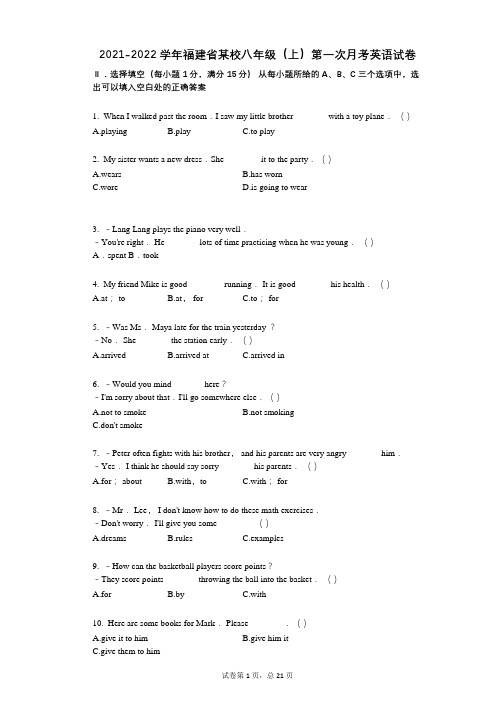
2021-2022学年福建省某校八年级(上)第一次月考英语试卷Ⅱ.选择填空(每小题1分,满分15分)从每小题所给的A、B、C三个选项中,选出可以填入空白处的正确答案1. When I walked past the room.I saw my little brother________with a toy plane.()A.playingB.playC.to play2. My sister wants a new dress.She ________it to the party.()A.wearsB.has wornC.woreD.is going to wear3. ﹣Lang Lang plays the piano very well.﹣You're right. He________lots of time practicing when he was young.()A.spent B.took4. My friend Mike is good________ running. It is good________his health.()A.at; toB.at, forC.to; for5. ﹣Was Ms. Maya late for the train yesterday ?﹣No. She________the station early.()A.arrivedB.arrived atC.arrived in6. ﹣Would you mind _______here?﹣I'm sorry about that.I'll go somewhere else.()A.not to smokeB.not smokingC.don't smoke7. ﹣Peter often fights with his brother, and his parents are very angry________him.﹣Yes. I think he should say sorry________his parents.()A.for; aboutB.with,toC.with; for8. ﹣Mr. Lee, I don't know how to do these math exercises.﹣Don't worry. I'll give you some________ ()A.dreamsB.rulesC.examples9. ﹣How can the basketball players score points?﹣They score points________throwing the ball into the basket.()A.forB.byC.with10. Here are some books for Mark. Please________.()A.give it to himB.give him itC.give them to him11. ﹣________can you________ anyone singing in the next room?﹣Oh, it's Lucy. She is practicing singing an English song.()A.Listen; hearB.Listen; listenC.Hear; listen12. The parents became ________when they got the ________news.()A.exciting; excitedB.excited; excitedC.excited; exciting13. John was not happy after the sports meet because he did________in boys' relay race.()A.wellB.stronglyC.badly14. My brother bought________ruler in the shop yesterday.()A.a one﹣meter﹣longB.an one﹣meter﹣longC.a one﹣meter long15. There ______ a football game this afternoon.A.will haveB.is going to haveC.is going to be三、完形填空.(15分)With the glory (光荣) of the Olympic Games, sports are very(1)_______to the people all over the world. We can enjoy(2)_______the skill and grace(优雅) of swimmers, runners and players. We can also watch our favorite athletes(运动员)compete(3)_______the others of different countries.All these you can do every four years. As we have TVs in front, we can be(4)_______to the modern Olympic Games.On color TV, we can see the opening﹣day ceremonies (开幕式). People feel excited to(5)_______their heroes. Your heart beats(跳动)fast as you see the five﹣star red flag(6)_______in the sky.A high point of the ceremonies is the lighting of the Olympic flame (火焰). You may want to know(7)_______a runner carries a flaming torch(火炬) to light the fire. That lighted torch (8)_______all the way from Olympia, Greece. It was relayed (9)_______hand to hand to the host country.The goal of Olympic athletes shows in their(10)_______, "Faster, higher and stronger". The most important thing in the game is not winning, but taking part in.(1)A.interestingB.excitingC.boring(2)A.watchingB.watchC.seeing(3)A.withB.forC.against(4)A.closeB.farC.great(5)A.join inB.cheer onC.turn into(6)A.to flyB.flyingC.fly(7)A.whatB.whyC.when(8)A.leftB.wentC.came(9)A.withB.fromC.between(10)A.symbolB.exampleC.motto四、阅读理解 45分If you ask an American to name a sport played with a bat and ball, you may get the name baseball.If you ask the same question of the people in England, you may get a different answer.They may say that the game is cricket.Who invented cricket? It is not very clear (清楚的).Many people think that children first played the game in the 1500s.Many sports began with children hitting some kinds of balls.Some people also believe people in India invented cricket.Adults (成年人) started to show interest in the bat and ball game in the 17th century.People made the rules for the sport.And a name for the sport came into being.The name may come from the bat used in the words crice of cryce.The two words mean a crutch(棒).The name may come from one of these words.根据短文内容,选择正确的答案.(1)From the first paragraph (段),we can know________.A.baseball is popular in EnglandB.American knows cricket betterC.American don't like cricket at allD.People in England like playing cricket.(2)People in________ may invent cricket.A.EnglandB.AmericaC.IndiaD.Japan.(3)Many people believe________ first played cricket many years ago.A.childrenB.teachersC.adultsD.boys.(4)Adults began to be interested in the sport________.A.2000years agoB.in the 1500'sC.in the 17th centuryD.in the 1800's.(5)The name of the sport may come from________.A.old EnglishB.old IndianC.the ballD.American English.Do you often do sports at school? In the UK, everyone has to do PE at school until the age of sixteen.Usually, 14 to 16﹣year﹣old students do about 100 minutes of sports a week at school, but this becomes 30 minutes a week for 17﹣ and 18﹣year﹣old students. If students enjoy PE, they can do sports at sports clubs after class. Schools work together with sports clubs. They hope students can do more sports. Here are some students' ideas about this.My favorite subject at school is PE. I like team sports, especially basketball. We train after school and play games against other schools once a week.(Blake, 15).I like dancing in the gym, but I don't like playing sports outside when it's cold or rainy.(Megan, 14)I play football for our school team and I love it. We train twice a week.(Drew, 16)(1)In the UK, school students should do PE until they are________.A. 12B. 14C. 16D. 20.(2)How long do 18﹣year﹣old students in the UK do sports a week?________A. 100 minutes.B. 70 minutes.C. 30 minutes.D. 20 minutes..(3)How often does Blake's school play games against other schools?________A. Once a week.B. Twice a week.C. Once a day.D. Twice a day..(4)Which of the following is NOT TRUE?________A. Blake likes PE best.B. Drew is 16 years old.C. Megan likes to play sports on cold days.D. Schools work with some sports clubs..(5)Where can you find this passage?________A. In a cooking book.B. In a sports newspaper.C. In a music bookD. In an animal book.There were two travelers(旅行者) in a forest (森林). They were hungry(饥饿)and they lost their way. Luckily, they met an old man. He told them when they saw a river, they could get out of the forest. And he gave them a basket of fresh fish and a fishing rod(钓鱼竿). One man took the fresh fish and the other man took the fishing rod. After that they thanked the old man and went on their way.A few days later, the one with fish ate up all the fish and died in the forest. The other man with the fishing rod couldn't walk a long way because he was too hungry. He died on the way to the river.There were another two hungry travelers in the same forest. They also got the same things from that old man. But they didn't ________. They left together and ate one fish a day. A few days later, they found the river and left the forest.The story tells us that alone we can do little, but together we can do so much.(1)What did the hungry men get from the old man?________A. A basket of fish and a rod.B. A basket of fish and a boat.C. One fish and a fishing rod.D. One fish and a fishing boat..(2)What happened to the first two men?________A. They walked out of the forest.B. Both of them died on the way.C. They had a big fight and died.D. Both of them became fishermen..(3)What does the underlined word "separate"mean in Chinese?________A.接受B. 合作C. 分开D.联系.(4)From paragraph 3, we can know the latter(后者的)two men________.A. didn't arrive at the riverB. loved to go fishing togetherC. died after a few daysD. left the forest.(5)What's the best title of this passage?________A. Working together is betterB. Don't travel alone in a forestC. How to live in a forestD. Eat fish or learn fishing.The game began. We ran around the playground with the ball. All the eleven players of my team did their best. We played as a team and passed the ball to each other.The first half was soon over with the score still 0﹣0.We went off the playground to have a break(休息).We sat around our PF teacher to listen to his words. When I drank water, I saw black clouds moving fast to us.The second half began. We were back on the playground. Our parents and friends shouted, "Go! Go!Go!" We had many chances to score, but the ball didn't go into the goal. But the other team scored once.Soon it rained heavily. We were wet (湿透的)and cold. But we didn't want to stop the game. We thought if we finished the game, we would win. However, the game still stopped because of the heavy rain. Our teacher came over and said, "You did very well! Winning is great! But playing hard and keeping fit is more important!"(1)What kind of game might they have?________A. A basketball game.B. A football game.C. A volleyball game.D. A table tennis game..(2)What did NOT the writer do at break time?________A. She drank some water.B. She listened to the PE teacher.C. She sat to have a break.D. She talked to her parents.(3)The score was________when the game stopped.A.0﹣0B.0﹣1C.1﹣1D.1﹣2.(4)The writer and her team didn't hope the game stopped because________.A.the weather would become good soonB.their parents and friends watched themC.they wanted to win the gameD.their teacher asked them to play.(5)What can we leam from the passage?________A.The two teams didn't score in the first halfB.It was rainy before they played in the second halfC.The writer's team had many chances to score in the first halfD.The writer's teacher wasn't happy with the score.Soccer is one of the most popular sports in the whole world.(1)_______In 1863, a group of people met in England.(2)_______They made a set of(﹣套)new rules forevery country to follow. After that, soccer teams from different douritries could play against each other.(3)_______ For example, each team has ll players and tries to get a ball into the other team's goal. Only the goalie can touch(接触) or move the ball with his arms or hands.Now teams from all over the world take part in the World Cup every four years.(4)_______The last World Cup was held in Brazil,South America. What's the next?It will be held in June.2018 in Russia (俄罗斯).(5)_______.把A﹣E五个选项填人文中空缺处,使短文内容完整、通顺.A.Let's look forward to it together.B.But many years ago, each country had its own kind of soccer game with its own rules.C.It's one of the most important things for all soccer fans.D.Some of the rules are still the same today.E.They made some changes to the game.五、情景交际 10分你想告诉父母将来做一名工程师,可以这么说:________ in the future.班长想请Alice不要开窗,他可以这样征求意见:Would you mind________ Alice?你想为刚刚向Paul所说的话道歉,可以这样说:Paul,________Tina想知道见面地点,她可以这样问对方:________?我们想把约会时间定在六点半,我可以这么说:________half past six.六、看图写话 10分看图写话eat, now________看图写话free, time________看图写话do badly in________看图写话dangerous, river________看图写话angry, teacher________七、短文填词 10分根据语境、音标或所给单词的提示填写单词,使短文完整、通顺.Do you know the Special Olympics? It is a world﹣class(1)________ (sport) event held every two years. The(2)________ (play) of the games are people with mental illness(智障).There's no world record to(3)________/breik/. And every player will get a medal. But the most important for the Special Olympics is to join in the games,(4)________/ʃeə(r)/ skill and joy(喜悦), not to get medals.China(5)________ ( hold) the Games in Shanghai in October, 2007.This two﹣week sports meeting was(6)________of love and care. The mascot (吉祥物) for the 2007 Special Olympics is " Sunshine Baby". It(7)________ ( show) the idea of enjoying sunshine and sharing joy. The theme (主题) of the game is "I know I can" andits logo(标志) is "The eye". It(8)________ (stand) for hope and care.The Special Olympics gave people in Shanghai a(9)________to show their newlook. The 2007 Special Olympics was(10)________ ( success).It is at least as important as the 2008 Beijing Olympics.八、书面表达 15分假如你是丁冬,你们班将举行主题为"我最爱的体育运动"的英文演讲活动.请你根据以下提示及要求,写一份英文演讲稿,谈谈你最喜欢的体育运动.提示:1、你最喜爱的运动是什么?2、喜爱这项运动的原因.要求:1.语言表达准确,短文连贯、通顺;2.包含所有提示内容并可适当增加内容,不少于70词.My favorite sport ________参考答案与试题解析2021-2022学年福建省某校八年级(上)第一次月考英语试卷Ⅱ.选择填空(每小题1分,满分15分)从每小题所给的A、B、C三个选项中,选出可以填入空白处的正确答案1.【答案】A【考点】其他动词短语【解析】当我走过房间时,我看见我弟弟正在玩玩具飞机.【解答】考查动词短语.A动名词/现在分词.A玩,动词原形.C不定式.句意"当我走过房间时,我看见我弟弟正在玩玩具飞机".see sb doing sth看到某人正在做某事.固定搭配.强调瞬间动作.故选:A.2.【答案】D【考点】一般将来时【解析】我的妹妹想要一件新裙子,她打算穿着去参加聚会.【解答】答案:D.根据语境推测句意是"我的妹妹想要一件新裙子,她打算穿着去参加晚会."结合前面一个句子用的是一般现在时,判断设空处的动作还没有发生,所以用一般将来时,一般将来时的构成是:主语+will/be going to+动词原形,故选D.3.【答案】根据句意:﹣Lang Lang弹钢琴很好.﹣你说的对,他年轻时花费很多时间练习.由practicing 推出考查句型spend…doing sth花费…做某事.take的句型是:it takes sb some time to do sth花费某人多长时间做某事.故选:A.【考点】其他动词短语【解析】﹣Lang Lang弹钢琴很好.﹣你说的对,他年轻时花费很多时间练习.【解答】根据句意:﹣Lang Lang弹钢琴很好.﹣你说的对,他年轻时花费很多时间练习.由practicing 推出考查句型spend…doing sth花费…做某事.take的句型是:it takes sbsome time to do sth花费某人多长时间做某事.故选:A.4.【答案】B【考点】其他动词短语【解析】我的朋友迈克擅长跑步,这对他的健康有好处.【解答】根据句意:我的朋友迈克擅长跑步,这对他的健康有好处.可知考查句型be good at擅长…,be good for对…与好处.be good to对…友好.故选:B.5.【答案】B【考点】其他动词短语【解析】﹣Ms. Maya 昨天的火车迟到了吗?﹣﹣﹣不,她早早到火车站了.【解答】根据句意:﹣Ms. Maya 昨天的火车迟到了吗?﹣﹣﹣不,她早早到火车站了.可知arrived at表示到达小地点,arrived in到达大地点,车站用arrived at.故选:B.6.【答案】B【考点】动名词【解析】﹣﹣你介意别在这儿吸烟吗?﹣﹣我很抱歉,我要去别的地方.【解答】答案:B 考查动名词.根据句意﹣﹣你介意别在这儿吸烟吗?﹣﹣我很抱歉,我要去别的地方.,考查固定短语mind doing sth介意做某事,否定式在mind后面加not,故答案是B.7.【答案】B【考点】介词辨析其他动词短语【解析】﹣彼得经常和他的弟弟打架,他的父母很生气.﹣是的.我认为他应该对他的父母说对不起.【解答】根据句意:﹣彼得经常和他的弟弟打架,他的父母很生气.﹣是的.我认为他应该对他的父母说对不起.可知考查句型: be angry with sb生某人的气,say sorry to sb对某人说对不起.这是介词的固定搭配.故选:B.8.【答案】C【考点】名词辨析【解析】﹣﹣﹣李先生,我不知道怎样做这些数学练习..﹣﹣﹣别担心.我将给你举一些例子.【解答】dreams"梦想";rules "规则";examples"例子、实例",三者都是名词的复数形式.由句意"﹣﹣﹣李先生,我不知道怎样做这些数学练习.﹣﹣﹣别担心.我将给你举一些例子."可知.答案应是 examples.故选:C.9.【答案】B【考点】介词辨析【解析】﹣篮球运动员怎样才能得分?﹣他们通过把球扔进篮筐得分.【解答】根据句意:﹣篮球运动员怎样才能得分?﹣他们通过把球扔进篮筐得分.可知考查句型by doing sth通过做某事,表示方式.结合选项,A.为了 B.通过 C.带有.故选:B.10.【答案】C【考点】其他动词短语【解析】这些书是给马克的.请把它们给他.【解答】根据句意:这些书是给马克的.请把它们给他.可知考查句型give sth to sb把某物给某人,如果是代词不能用句型give sb sth.books用them代替.故选:C.11.【答案】A【考点】同义词、近义词的辨析【解析】﹣﹣听,你能听到隔壁有人正在唱歌吗?﹣﹣哦,是露西.她正在练习唱英文歌曲.【解答】考查同义词.listen听,表示听的动作.hear听,表示听的结果.第一个空,表示"听的动作"用listen听.第二个空,结合语境"你能听到隔壁有人正在唱歌吗"表示听的结果,用hear.故选:A.12.【答案】C【考点】ing形容词和ed形容词【解析】当父母得到这个令人兴奋的消息时,他们兴奋起来.【解答】一般ing形容词的修饰物和ed形容词修饰人,根据The parents became when they got the news,第一个空修饰parents ,是人,第二个空修饰news是物.故选:C.13.【答案】C【考点】副词辨析【解析】约翰运动会后不高兴,因为他在男孩接力赛中表现不好.【解答】考查副词.A好.B强壮地.C不好、坏.结合语境"约翰运动会后不高兴,因为他在男孩接力赛中表现__"可知,应该是不好.故选:C.14.【答案】A【考点】复合形容词【解析】我弟弟昨天在商店里买了一个一米长的尺子.【解答】考查复合形容词.根据空缺处后面的词是名词,可以确定空缺处需要有形容词进行修饰.one﹣meter﹣long可以表达出"一米长的",再看数量,确定是一把尺子,所以要结合one的语音,第一个字母o,但是发音是w/开头,不是元音音素,所以要用a.故选:A.15.【答案】C【考点】there be 句型一般将来时【解析】此题暂无解析【解答】C 考查there be句型的一般将来时。
- 1、下载文档前请自行甄别文档内容的完整性,平台不提供额外的编辑、内容补充、找答案等附加服务。
- 2、"仅部分预览"的文档,不可在线预览部分如存在完整性等问题,可反馈申请退款(可完整预览的文档不适用该条件!)。
- 3、如文档侵犯您的权益,请联系客服反馈,我们会尽快为您处理(人工客服工作时间:9:00-18:30)。
使用Win32线程API1线程创建实例1#include "stdafx.h"#include <windows.h>#include <iostream>using namespace std;DWORD WINAPI FunOne(LPVOID param){while(1){Sleep(1000);cout<<"This is FunOne "<<endl;}return 1;}DWORD WINAPI FunTwo(LPVOID param){while(1){Sleep(1000);cout<<"This is FunTwo "<<endl;}return 1;}int main(int argc, char* argv[]){DWORD lp1=0,lp2=0;HANDLE hand1=CreateThread (NULL, 0, FunOne, NULL, CREATE_SUSPENDED, &lp1); HANDLE hand2=CreateThread (NULL, 0, FunTwo, NULL, CREATE_SUSPENDED, &lp2); system("pause");ResumeThread(hand1);ResumeThread(hand2);system("pause");return 0;}2线程创建实例 2#include "stdafx.h"#include <windows.h>#include <process.h>#include <iostream>#include <fstream>using namespace std;void ThreadFunc1(PVOID param){Sleep(10000);cout<<"This is ThreadFunc1"<<endl;}void ThreadFunc2(PVOID param){Sleep(10000);cout<<"This is ThreadFunc2"<<endl;}void ThreadFunc3(PVOID param){Sleep(10000);cout<<"This is ThreadFunc2"<<endl;}int main(){int i=0;_beginthread(ThreadFunc1,0,NULL);_beginthread(ThreadFunc2,0,NULL);Sleep(3000);cout<<"end"<<endl;return 0;}3线程管理实例#include "stdafx.h"#include <windows.h>#include <iostream>using namespace std;DWORD WINAPI FunOne(LPVOID param){while(true){Sleep(1000);cout<<"hello! ";}return 0;}DWORD WINAPI FunTwo(LPVOID param){while(true){Sleep(1000);cout<<"world! ";}return 0;}int main(int argc, char* argv[]){int input=0;DWORD lp1=0,lp2=0;HANDLE hand1=CreateThread (NULL, 0, FunOne, (void*)&input, CREATE_SUSPENDED, &lp1); HANDLE hand2=CreateThread (NULL, 0, FunTwo, (void*)&input, CREATE_SUSPENDED, &lp2); while(true){cin>>input;if(input==1){ResumeThread(hand1);ResumeThread(hand2);}if(input==2){SuspendThread(hand1);SuspendThread(hand2);}if(input==0){TerminateThread(hand1,1);TerminateThread(hand2,1);}if(input==9)return 0;};return 0;}4同步——全局变量#include "stdafx.h"#include <windows.h>#include <iostream>using namespace std;int globalvar = false;DWORD WINAPI ThreadFunc(LPVOID pParam){cout<<"ThreadFunc"<<endl;Sleep(200);globalvar = true;return 0;}int main(){HANDLE hthread = CreateThread(NULL, 0, ThreadFunc, NULL, 0, NULL);if (!hthread){cout<<"Thread Create Error ! "<<endl;CloseHandle(hthread);}while (!globalvar)cout<<"Thread while"<<endl;cout<<"Thread exit"<<endl;return 0;}5事件机制应用实例#include "stdafx.h"#include <windows.h>#include <process.h>#include <iostream>#include <fstream>using namespace std;HANDLE evRead, evFinish;void ReadThread(LPVOID param){WaitForSingleObject (evRead ,INFINITE);cout<<"Reading"<<endl;SetEvent (evFinish);}void WriteThread(LPVOID param){cout<<"Writing"<<endl;SetEvent (evRead);}int main(int argc , char * argv[]){evRead = CreateEvent (NULL ,FALSE ,FALSE ,NULL) ;evFinish = CreateEvent (NULL ,FALSE ,FALSE ,NULL) ;_beginthread(ReadThread , 0 , NULL) ;_beginthread(WriteThread , 0 , NULL) ;WaitForSingleObject (evFinish,INFINITE) ;cout<<"The Program is End"<<endl;return 0 ;}6临界区同步机制实例#include "stdafx.h"#include <windows.h>#include <process.h>#include <iostream>#include <fstream>using namespace std;int total = 100 ;HANDLE evFin[2] ;CRITICAL_SECTION cs ;void WithdrawThread1(LPVOID param){EnterCriticalSection(&cs) ;if ( total-90 >= 0){total -= 90 ;cout<<"You withdraw 90"<<endl;}elsecout<<"You do not have that much money"<<endl;LeaveCriticalSection(&cs) ;SetEvent (evFin[0]) ;}void WithdrawThread2(LPVOID param){EnterCriticalSection(&cs) ;if ( total-20 >= 0){total -= 20 ;cout<<"You withdraw 20"<<endl;}elsecout<<"You do not have that much money"<<endl;LeaveCriticalSection(&cs) ;SetEvent (evFin[1]) ;}int main(int argc , char * argv[]){evFin[0] = CreateEvent (NULL,FALSE,FALSE,NULL) ;evFin[1] = CreateEvent (NULL,FALSE,FALSE,NULL) ;InitializeCriticalSection(&cs) ;_beginthread(WithdrawThread1 , 0 , NULL) ;_beginthread(WithdrawThread2 , 0 , NULL) ;WaitForMultipleObjects(2 ,evFin ,TRUE ,INFINITE) ;DeleteCriticalSection(&cs) ;cout<<total<<endl;return 0 ;}7互斥量同步机制实例#include "stdafx.h"#include <windows.h>#include <iostream>#define THREAD_INSTANCE_NUMBER 3using namespace std;LONG g_fResourceInUse = FALSE;LONG g_lCounter = 0;DWORD ThreadProc(void * pData) {int ThreadNumberTemp = (*(int*) pData);HANDLE hMutex;if ((hMutex = OpenMutex(MUTEX_ALL_ACCESS, FALSE, "Mutex.Test")) == NULL) { cout << "Open Mutex error!" << endl;}WaitForSingleObject( hMutex, INFINITE);cout<< "ThreadProc: " << ThreadNumberTemp << " is running!" << endl;cout << "ThreadProc " << ThreadNumberTemp << " gets the mutex"<< endl;ReleaseMutex(hMutex);CloseHandle(hMutex);return 0;}int main(int argc, char* argv[]){int i;DWORD ID[THREAD_INSTANCE_NUMBER];HANDLE h[THREAD_INSTANCE_NUMBER];HANDLE hMutex;if ( (hMutex = OpenMutex(MUTEX_ALL_ACCESS, FALSE, "Mutex.Test")) == NULL) { if ((hMutex = CreateMutex(NULL, FALSE, "Mutex.Test")) == NULL ) { cout << "Create Mutex error!" << endl;return 0;}}for (i=0;i<THREAD_INSTANCE_NUMBER;i++){WaitForSingleObject( hMutex, INFINITE);h[i] = CreateThread(NULL, 0, (LPTHREAD_START_ROUTINE) ThreadProc, (void *)&ID[i],0,&(ID[i]));if (h[i] == NULL)cout << "CreateThread error" << ID[i] << endl;elsecout << "CreateThread: " << ID[i] << endl;ReleaseMutex(hMutex);}WaitForMultipleObjects(THREAD_INSTANCE_NUMBER,h,TRUE,INFINITE);cout << "Close the Mutex Handle! " << endl;CloseHandle(hMutex);system("pause");return 0;}8信号量同步机制实例1#include"stdafx.h"#include<windows.h>#include<iostream>using namespace std;#define THREAD_INSTANCE_NUMBER 3DWORD foo(void * pData) {int ThreadNumberTemp = (*(int*) pData);HANDLE hSemaphore;if ((hSemaphore = OpenSemaphore(SEMAPHORE_ALL_ACCESS, FALSE, "Semaphore.Test")) == NULL) {cout << "Open Semaphore error!" << endl;}WaitForSingleObject(hSemaphore, // handle to semaphoreINFINITE); // zero-second time-out intervalcout << "foo: " << ThreadNumberTemp << " is running!" << endl;cout << "foo " << ThreadNumberTemp << " gets the semaphore"<< endl;ReleaseSemaphore(hSemaphore, 1, NULL);CloseHandle(hSemaphore);return 0;}int main(int argc, char* argv[]){int i;DWORD ThreadID[THREAD_INSTANCE_NUMBER];HANDLE hThread[THREAD_INSTANCE_NUMBER];HANDLE hSemaphore;if ((hSemaphore = CreateSemaphore(NULL,1,1, "Semaphore.Test")) == NULL ) { cout << "Create Semaphore error!" << endl;return 0;}for (i=0;i<THREAD_INSTANCE_NUMBER;i++){WaitForSingleObject(hSemaphore, // handle to semaphoreINFINITE); // zero-second time-out intervalhThread[i] = CreateThread(NULL,0,(LPTHREAD_START_ROUTINE) foo,(void *)&ThreadID[i],0,&(ThreadID[i]));if (hThread[i] == NULL)cout << "CreateThread error" << ThreadID[i] << endl;elsecout << "CreateThread: " << ThreadID[i] << endl;ReleaseSemaphore(hSemaphore, 1, NULL);}WaitForMultipleObjects(THREAD_INSTANCE_NUMBER,hThread,TRUE,INFINITE);cout << "Close the Semaphore Handle! " << endl;CloseHandle(hSemaphore);system("pause");return 0;}信号量同步机制实例2#include"stdafx.h"#include<windows.h>#include<iostream>using namespace std;int seats=9;CRITICAL_SECTION cs ;#define THREAD_INSTANCE_NUMBER 50DWORD foo(void * pData) {int ThreadNumberTemp = (*(int*) pData);HANDLE hSemaphore;if ((hSemaphore = OpenSemaphore(SEMAPHORE_ALL_ACCESS, FALSE, "Semaphore.Test")) == NULL) {cout << "Open Semaphore error!" << endl;}WaitForSingleObject(hSemaphore, // handle to semaphoreINFINITE); // zero-second time-out intervalEnterCriticalSection(&cs) ;seats--;cout << seats<<endl ;LeaveCriticalSection(&cs) ;Sleep(2060);EnterCriticalSection(&cs) ;seats++;cout << seats <<endl;LeaveCriticalSection(&cs) ;ReleaseSemaphore(hSemaphore, 1, NULL);CloseHandle(hSemaphore);return 0;}int main(int argc, char* argv[]){int i;DWORD ThreadID[THREAD_INSTANCE_NUMBER];HANDLE hThread[THREAD_INSTANCE_NUMBER];HANDLE hSemaphore;if ((hSemaphore = CreateSemaphore(NULL,9,9, "Semaphore.Test")) == NULL ) { cout << "Create Semaphore error!" << endl;return 0;}InitializeCriticalSection(&cs) ;for (i=0;i<THREAD_INSTANCE_NUMBER;i++){//WaitForSingleObject(// hSemaphore, // handle to semaphore// INFINITE); // zero-second time-out intervalhThread[i] = CreateThread(NULL,0,(LPTHREAD_START_ROUTINE) foo,(void *)&ThreadID[i],0,&(ThreadID[i]));// if (hThread[i] == NULL)// cout << "CreateThread error" << ThreadID[i] << endl;// else// cout << "CreateThread: " << ThreadID[i] << endl;// ReleaseSemaphore(hSemaphore, 1, NULL);}WaitForMultipleObjects(THREAD_INSTANCE_NUMBER,hThread,TRUE,INFINITE);//cout << "Close the Semaphore Handle! " << endl;CloseHandle(hSemaphore);DeleteCriticalSection(&cs) ;system("pause");return 0;}MFC多线程程序设计(主要代码)#include"stdafx.h"#include"exa8.h"#include"MainFrm.h"#ifdef _DEBUG#define new DEBUG_NEW#undef THIS_FILEstatic char THIS_FILE[] = __FILE__;#endifHANDLE g_hBusy;HWND hwnd;int k=0;long data1[] = {12,32,47,763,75,43,86,42};long data2[] = {432,68,36,84,47,73,732,46};long data3[] = {435,754,37,765,48,785,326,78};long data4[] = {54,76,93,457,456,34,94,50};/////////////////////////////////////////////////////////////////////////////// CMainFrameIMPLEMENT_DYNCREATE(CMainFrame, CFrameWnd)BEGIN_MESSAGE_MAP(CMainFrame, CFrameWnd)//{{AFX_MSG_MAP(CMainFrame)// NOTE - the ClassWizard will add and remove mapping macros here.// DO NOT EDIT what you see in these blocks of generated code !ON_WM_CREATE()//}}AFX_MSG_MAPEND_MESSAGE_MAP()static UINT indicators[] ={ID_SEPARATOR, // status line indicatorID_INDICATOR_CAPS,ID_INDICATOR_NUM,ID_INDICATOR_SCRL,};int QuickSort(long* Array, int iLow, int iHigh)//快速排序程序{ if(iLow >= iHigh)return 1;long pivot = Array[iLow];int iLowSaved = iLow;int iHighSaved = iHigh;int n=0;for (int m=1; m<100000000;m++ )n++;while (iLow < iHigh){while (Array[iHigh] >= pivot && iHigh > iLow)iHigh --;Array[iLow] = Array[iHigh];while (Array[iLow]< pivot && iLow < iHigh)iLow++;Array[iHigh] = Array[iLow];}Array[iLow] = pivot;QuickSort(Array,iLowSaved,iHigh-1);QuickSort(Array, iLow+1, iHighSaved);return 0;}UINT DataProcess(LPVOID p){ long* Array = (long*)p;char pszMsg[512];memset(pszMsg,'\0',512);DWORD dwRet;int i;QuickSort( Array, 0, 7);dwRet = WaitForSingleObject(g_hBusy, INFINITE) ;for(i=0; i<8; i++){ sprintf(pszMsg, "%d ", Array[i]);SendMessage(hwnd, EM_REPLACESEL, true, (LPARAM)(pszMsg));Sleep(100);}sprintf(pszMsg, "\r\n");SendMessage(hwnd, EM_REPLACESEL, true, (LPARAM)(pszMsg));ReleaseSemaphore(g_hBusy, 1, NULL);//给g_hBusy信号量加return 0;}// CMainFrame construction/destructionCMainFrame::CMainFrame(){// TODO: add member initialization code here}CMainFrame::~CMainFrame(){}int CMainFrame::OnCreate(LPCREATESTRUCT lpCreateStruct){if (CFrameWnd::OnCreate(lpCreateStruct) == -1)return -1;if (!m_wndToolBar.CreateEx(this, TBSTYLE_FLAT, WS_CHILD | WS_VISIBLE | CBRS_TOP | CBRS_GRIPPER | CBRS_TOOLTIPS | CBRS_FLYBY | CBRS_SIZE_DYNAMIC) ||!m_wndToolBar.LoadToolBar(IDR_MAINFRAME)){TRACE0("Failed to create toolbar\n");return -1; // fail to create}if (!m_wndStatusBar.Create(this) ||!m_wndStatusBar.SetIndicators(indicators,sizeof(indicators)/sizeof(UINT))){TRACE0("Failed to create status bar\n");return -1; // fail to create}// TODO: Delete these three lines if you don't want the toolbar to// be dockablem_wndToolBar.EnableDocking(CBRS_ALIGN_ANY);EnableDocking(CBRS_ALIGN_ANY);DockControlBar(&m_wndToolBar);return 0;}BOOL CMainFrame::PreCreateWindow(CREATESTRUCT& cs){if( !CFrameWnd::PreCreateWindow(cs) )return FALSE;// TODO: Modify the Window class or styles here by modifying// the CREATESTRUCT csreturn TRUE;}///////////////////////////////////////////////////////////////////////////// // CMainFrame diagnostics#ifdef _DEBUGvoid CMainFrame::AssertValid() const{CFrameWnd::AssertValid();}void CMainFrame::Dump(CDumpContext& dc) const{CFrameWnd::Dump(dc);}#endif//_DEBUG///////////////////////////////////////////////////////////////////////////// // CMainFrame message handlersvoid CMainFrame::Start(){g_hBusy = CreateSemaphore(NULL, 1, 1, NULL);hwnd=m_hwndViewEdit;AfxBeginThread(DataProcess, (LPVOID)data1, THREAD_PRIORITY_NORMAL);AfxBeginThread(DataProcess, (LPVOID)data2, THREAD_PRIORITY_NORMAL);AfxBeginThread(DataProcess, (LPVOID)data3, THREAD_PRIORITY_NORMAL);AfxBeginThread(DataProcess, (LPVOID)data4, THREAD_PRIORITY_NORMAL);}.NET框架下创建线程实例using System;using System.Threading;class Test{static void Main(){ThreadStart threadDelegate = new ThreadStart(Work.DoWork);Thread newThread = new Thread(threadDelegate);newThread.Start();Work w = new Work();w.Data = 42;threadDelegate = new ThreadStart(w.DoMoreWork);newThread = new Thread(threadDelegate);newThread.Start();Console.Read();}}class Work{public static void DoWork(){Console.WriteLine("Static thread procedure.");}public int Data;public void DoMoreWork(){for (int i = 1; i <= 500000000; i++){Data++;}Console.WriteLine("Instance thread procedure. Data={0}", Data);}}.NET框架下同步机制using System;using System.Threading;class Test{static private Object thisLock = new Object();static int total = 100,m=0;public static void WithDraw1(){int n=90;lock (thisLock){if (n <= total){for (int i = 0; i < 200000000; i++)m++;total -= n;Console.WriteLine("You have withdrawn. n={0}", n);Console.WriteLine("total={0}", total);}else{Console.WriteLine("You do not enough money. n={0}", n);Console.WriteLine("total={0}", total);}}}public static void WithDraw2(){int n = 20;lock (thisLock){if (n <= total){for (int i = 0; i < 200000000; i++)m++;total -= n;Console.WriteLine("You have withdrawn. n={0}", n);Console.WriteLine("total={0}", total);}else{Console.WriteLine("You do not enough money. n={0}", n);Console.WriteLine("total={0}", total);}}}public static void Main(){ThreadStart thread1 = new ThreadStart(WithDraw1);Thread newThread1 = new Thread(thread1);ThreadStart thread2 = new ThreadStart(WithDraw2);Thread newThread2 = new Thread(thread2);newThread1.Start();newThread2.Start();Console.Read();}}Linux多线程编程1、基本线程操作#include<stdio.h>#include<stdlib.h>#include<unistd.h>#include<pthread.h>#define THREAD_NUMBER 2int retval_hello1= 2, retval_hello2 = 3;void* hello1(void *arg){char *hello_str = (char *)arg;sleep(1);printf("%s\n", hello_str);pthread_exit(&retval_hello1);}void* hello2(void *arg){char *hello_str = (char *)arg;sleep(2);printf("%s\n", hello_str);pthread_exit(&retval_hello2);}int main(int argc, char *argv[]){int i;int ret_val;int *retval_hello[2];pthread_t pt[THREAD_NUMBER];const char *arg[THREAD_NUMBER];arg[0] = "hello world from thread1";arg[1] = "hello world from thread2";printf("Begin to create threads...\n");ret_val = pthread_create(&pt[0], NULL, hello1, (void *)arg[0]);if (ret_val != 0 ) {printf("pthread_create error!\n");exit(1);}ret_val = pthread_create(&pt[1], NULL, hello2, (void *)arg[1]);if (ret_val != 0 ) {printf("pthread_create error!\n");exit(1);}printf("Begin to wait for threads...\n");for(i = 0; i < THREAD_NUMBER; i++) {ret_val = pthread_join(pt[i], (void **)&retval_hello[i]);if (ret_val != 0) {printf("pthread_join error!\n");exit(1);} else {printf("return value is %d\n", *retval_hello[i]);}}printf("Now, the main thread returns.\n");return 0;}2、线程属性操作#include<stdio.h>#include<stdlib.h>#include<pthread.h>void* sum_val(void *arg){int sum = 0;int i;int count = *(int *)arg;for (i = 0; i < count; i++)sum = sum + i;printf("sum is %d\n", sum);pthread_exit(0);}int main(int argc, char *argv[]){pthread_t pt;int count = 10;int ret_val;pthread_attr_t attr;struct sched_param sp;sp.__sched_priority = 2;ret_val = pthread_attr_init(&attr);if (ret_val != 0) {printf("pthread_attr_init error!\n");exit(1);}ret_val = pthread_attr_setdetachstate(&attr, PTHREAD_CREATE_DETACHED);if (ret_val != 0) {printf("pthread_attr_setdetachstate error!\n");exit(1);}ret_val = pthread_attr_setschedpolicy(&attr, SCHED_RR);if (ret_val != 0) {printf("pthread_attr_setschedpolicy error!\n");exit(1);}ret_val = pthread_attr_setschedparam(&attr, &sp);if (ret_val != 0) {printf("pthread_attr_setschedparam error!\n");exit(1);}ret_val = pthread_attr_setinheritsched(&attr, PTHREAD_EXPLICIT_SCHED);if (ret_val != 0) {printf("pthread_attr_setinheritsched error!\n");exit(1);}ret_val = pthread_attr_setscope(&attr, PTHREAD_SCOPE_SYSTEM);if (ret_val != 0) {printf("pthread_attr_setscope error!\n");exit(1);}ret_val = pthread_create(&pt, NULL, sum_val, (void *)&count);if (ret_val != 0 ) {printf("pthread_create error!\n");exit(1);}pthread_attr_destroy(&attr);sleep(5);return 0;}3、使用mutex实例#include<stdio.h>#include<stdlib.h>#include<pthread.h>#include<errno.h>#define THREAD_NUMBER 10static pthread_mutex_t mutex = PTHREAD_MUTEX_INITIALIZER;int sum =0;void* inc(void *arg){int i =(*(int *)arg);pthread_mutex_lock(&mutex);sum = sum +i;pthread_mutex_unlock(&mutex);return NULL;}int main(int argc, char *argv[]){pthread_t pt[THREAD_NUMBER];int i;int arg[THREAD_NUMBER];for(i=0; i<THREAD_NUMBER; i++) {arg[i]=i;if(pthread_create(&pt[i], NULL, inc, (void *)&arg[i])!=0){ printf("pthread_create error\n");exit(1);}}for(i=0; i<THREAD_NUMBER; i++)if(pthread_join(pt[i],NULL)!=0){printf("pthread_join error\n");exit(1);}printf("sum is %d\n",sum);pthread_mutex_destroy(&mutex);return 0;}4、使用条件变量实例#include<stdio.h>#include<stdlib.h>#include<unistd.h>#include<pthread.h>#define THREAD_NUMBER 2static pthread_cond_t cond = PTHREAD_COND_INITIALIZER; static pthread_mutex_t mutex = PTHREAD_MUTEX_INITIALIZER;void* thread1(void *arg){pthread_mutex_lock(&mutex);printf("thread1 locked the mutex\n");printf("thread1 is waiting for condition signal...\n"); pthread_cond_wait(&cond, &mutex);printf("thread1 received condition signal!\n");pthread_mutex_unlock(&mutex);printf("thread1 unlocked the mutex\n");pthread_exit(0);}void* thread2(void *arg){int i = 0;struct timeval old, new;gettimeofday(&old);new = old;pthread_mutex_lock(&mutex);printf("thread2 locked the mutex\n");while (_sec - _sec < 5) {sleep(1);gettimeofday(&new);i++;printf("thread2 sleep %d seconds\n", i);}printf("thread1 calls pthread_cond_signal...\n");pthread_cond_signal(&cond);pthread_mutex_unlock(&mutex);printf("thread2 unlocked the mutex\n");pthread_exit(0);}int main(int argc, char *argv[]){int i;int ret_val;pthread_t pt[THREAD_NUMBER];ret_val = pthread_create(&pt[0], NULL, thread1, NULL);if (ret_val != 0 ) {printf("pthread_create error!\n");exit(1);}ret_val = pthread_create(&pt[1], NULL, thread2, NULL);if (ret_val != 0 ) {printf("pthread_create error!\n");exit(1);}for (i = 0; i < THREAD_NUMBER; i++) {ret_val = pthread_join(pt[i], NULL);if (ret_val != 0) {printf("pthread_join error!\n");exit(1);}}pthread_mutex_destroy(&mutex);pthread_cond_destroy(&cond);return 0;}5、使用等待时间限制的条件变量的实例#include<stdio.h>#include<stdlib.h>#include<unistd.h>#include<time.h>#include<pthread.h>#include<errno.h>#define THREAD_NUMBER 2static pthread_cond_t cond = PTHREAD_COND_INITIALIZER;static pthread_mutex_t mutex = PTHREAD_MUTEX_INITIALIZER;static int x = 0, y = 0;void* thread1(void *arg){struct timeval now;struct timespec timeout;int retcode;pthread_mutex_lock(&mutex);gettimeofday(&now, NULL);_sec = _sec + 5;_nsec = _usec * 1000;retcode = 0;while (x >= y && retcode != ETIMEDOUT) {retcode = pthread_cond_timedwait(&cond, &mutex, &timeout); }if (retcode == ETIMEDOUT) {printf("pthread_cond_timedwait timeout!\n");} else {printf("thread1 got condition signal!\n");}pthread_mutex_unlock(&mutex);pthread_exit(0);}void* thread2(void *arg){int i;for (i = 0; i < 5; i++) {x = rand() % 5;y = rand() % 5;sleep(1);printf("x is %d, y is %d\n", x ,y);if ( x < y)break;}pthread_mutex_lock(&mutex);if (x < y) {pthread_cond_broadcast(&cond);}pthread_mutex_unlock(&mutex);pthread_exit(0);}int main(int argc, char *argv[]){int i;int ret_val;pthread_t pt[THREAD_NUMBER];ret_val = pthread_create(&pt[0], NULL, thread1, NULL);if (ret_val != 0 ) {printf("pthread_create error!\n");exit(1);}ret_val = pthread_create(&pt[1], NULL, thread2, NULL);if (ret_val != 0 ) {printf("pthread_create error!\n");exit(1);}for (i = 0; i < THREAD_NUMBER; i++) {ret_val = pthread_join(pt[i], NULL);if (ret_val != 0) {printf("pthread_join error!\n");exit(1);}}pthread_mutex_destroy(&mutex);pthread_cond_destroy(&cond);return 0;}OpenMP编程实例1、简单并行区域编程#include "stdafx.h"#include "omp.h"int _tmain(int argc, _TCHAR* argv[]){printf("Hello from serial.\n");printf("Thread number = %d\n",omp_get_thread_num()); //串行执行#pragma omp parallel //开始并行执行{printf("Hello from parallel. Thread number=%d\n",omp_get_thread_num());}printf("Hello from serial again.\n");return 0;}2、数据相关程序实例#include"stdafx.h"#include"omp.h"#include"windows.h"#include<stdlib.h>int x[100],y[100],k;int _tmain(int argc, _TCHAR* argv[]){x[0] = 0;y[0] = 1;//#pragma omp parallel for private(k)for (k = 1; k < 100; k++){x[k] = y[k-1] + 1; //S1y[k] = x[k-1] + 2; //S2}printf("y=%d\n",y[99]);printf("x=%d\n",x[99]);return 0;}3、#include"stdafx.h"#include"omp.h"#include"windows.h"#include<stdlib.h>int x[100],y[100],k,m;int _tmain(int argc, _TCHAR* argv[]){x[0] = 0;y[0] = 1;x[49] = 74;y[49] = 74 ;//#pragma omp parallel for private(k)#pragma omp parallel for private(m, k)for (m = 0; m < 2; m++){for (k = m*49 + 1; k < m*50 + 50; k++){x[k] = y[k-1] + 1; //S1y[k] = x[k-1] + 2; //S2}}printf("y=%d\n",y[99]);printf("x=%d\n",x[99]);return 0;}4、循环嵌套#include"stdafx.h"#include"omp.h"int _tmain(int argc, _TCHAR* argv[]){int i;int j;#pragma omp parallel for//#pragma omp parallel for private(j)for(i=0;i<4;i++)for(j=6;j<10;j++)printf("i=%d j=%d\n",i,j);printf("######################\n");for(i=0;i<4;i++)#pragma omp parallel forfor(j=6;j<10;j++)printf("i=%d j=%d\n",i,j);return 0;}5控制数据的共享属性——私有变量的初始化和终结操作实例#include "stdafx.h"#include "omp.h"#include "windows.h"int _tmain(int argc, _TCHAR* argv[]){int val=8;#pragma omp parallel for firstprivate(val) lastprivate(val)for(int i=0;i<2;i++){printf("i=%d val=%d\n",i,val);if(i==1)val=10000;printf("i=%d val=%d\n",i,val);}printf("val=%d\n",val);return 0;}6 并行区域编程#include "stdafx.h"#include "windows.h"#include "omp.h"int _tmain(int argc, _TCHAR* argv[]){printf("first execution.\n");#pragma omp parallelfor(int i=0;i<5;i++)printf("hello world i=%d\n",i);printf("second exectuion.\n");#pragma omp parallel forfor(int i=0;i<5;i++)printf("hello world i=%d\n",i);return 0;}7 数据竞争#include "stdafx.h"#include "windows.h"#include "omp.h"。
